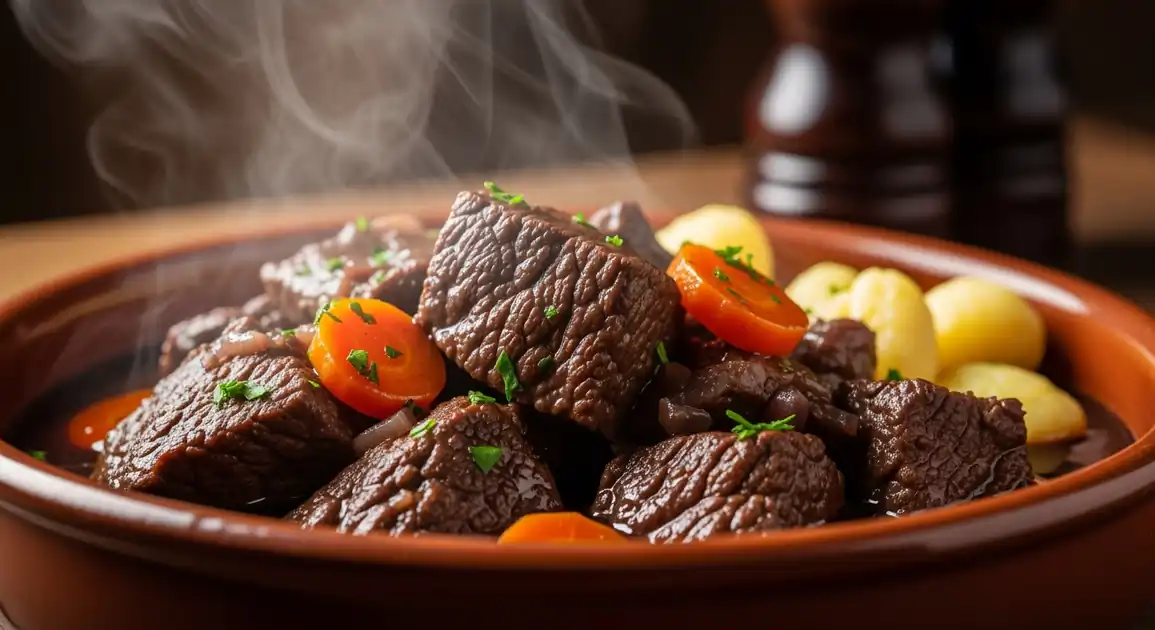Daube Provençale (Provençal Beef Stew)
Daube Provençale

Description
Daube Provençale is a celebrated regional dish found primarily in the South of France (Provence-Alpes-Côte d'Azur region), but its popularity means it can sometimes be found in traditional bistros across the country, especially during colder months. It represents French comfort food at its best.
Dietary Information
Serving information
Serving style
Served hot in a deep bowl or traditional 'daubière', usually accompanied by pasta, gnocchi, or polenta. A basket of crusty bread is standard alongside.
Quick facts
Lunch: approx. 12 PM - 2:30 PM. Dinner: approx. 7 PM - 10:30 PM. Varies by establishment.
Safety Tips
What to Look For
-
Served piping hot
Ensures the stew has been held and served at a safe temperature, minimizing bacterial risk. Stews should be visibly steaming.
-
Reputable establishment (Bistro/Restaurant)
Choose places known for traditional French cuisine or with good local reviews. Avoid questionable tourist traps.
-
Rich, savory aroma
A good Daube smells deeply of wine, herbs, and beef. Any sour, metallic, or 'off' smells are red flags.
-
Beef is extremely tender
While more a sign of quality, properly slow-cooked meat reaches temperatures ensuring safety. Tough meat might indicate rushed cooking.
What to avoid
-
Stew served lukewarm or cool
Indicates improper holding temperature, a significant food safety risk for pre-cooked dishes.
-
Visible signs of poor hygiene in the restaurant
Dirty tables, cutlery, or staff handling food improperly should be avoided.
-
Watery or greasy sauce
Often indicates poor preparation (not reduced enough, too much fat not skimmed), affecting quality rather than primary safety, but can signal carelessness.
-
Establishments where food sits out visibly for long periods
Pre-cooked stews should be kept properly hot or refrigerated, not left at room temperature.
Price information
Price range
Budget tips
- Look for 'Plat du Jour' (Dish of the Day) specials at lunchtime bistros for better value.
- Prices are generally lower outside major tourist hubs.
- Market caterers ('traiteurs') might offer take-away Daube at lower prices than restaurants.
Value indicators
- Meat tenderness (should be meltingly soft).
- Depth and richness of the sauce flavor.
- Quality of the accompanying pasta/gnocchi/polenta.
- Served in a traditional earthenware dish ('daubière' or similar).
- Good reviews from locals.
Where to Find This Dish
Provence Region
Most authentic and widely available in its home region (cities like Marseille, Aix-en-Provence, Avignon, Nice).
Local bistros, Traditional restaurants
Lunchtime, Dinner
Traditional Bistros Nationwide
Can be found in bistros specializing in classic French cuisine, especially in Paris or Lyon, during colder seasons.
Classic French bistros
Lunchtime, Dinner (seasonal)
Vendor Tips
- Look for restaurants advertising 'Cuisine Provençale' or 'Cuisine Traditionnelle'.
- Ask if the Daube is 'fait maison' (homemade).
- Check reviews online or ask hotel concierges for recommendations.
How to Order
Regional Variations
-
Daube Avignonnaise
(Daube Avignonnaise)
A variation typically made with lamb shoulder instead of beef, often including white wine alongside red, and sometimes olives.
-
Daube Niçoise
(Daube Niçoise)
Originating near Nice, this version often incorporates mushrooms (like cèpes), olives, and sometimes uses lamb or a mix of meats. Often served with gnocchi.
-
Daube à la Marseillaise
(Daube à la Marseillaise)
While not strictly defined, versions in Marseille might emphasize more robust flavors, potentially including more garlic, olives, or pastis for aroma.
-
Serving Variations
(Variations d'Accompagnement)
While the stew itself varies, common accompaniments include pasta (tagliatelle, pappardelle), gnocchi, polenta, or sometimes potatoes.
Cultural context
History
Rooted in the peasant cooking of Provence, Daube was traditionally cooked in a special pot called a 'daubière', often sealed with paste and left to simmer for hours by the fire. It was a way to tenderize tougher cuts of meat using local ingredients like red wine and herbs. Over time, it evolved into a beloved regional classic, representing the rustic yet flavorful heart of Provençal cuisine. Its name derives from 'adobar' (Provençal dialect), meaning to prepare or arrange.
Local significance
A cornerstone of Provençal culinary heritage, representing rustic, slow-cooked family food.
Eating customs
- Using bread to soak up the sauce ('saucer' in French) is common practice.
- Enjoying it with a glass of local red wine.
- Considered a comforting, warming dish for colder weather.